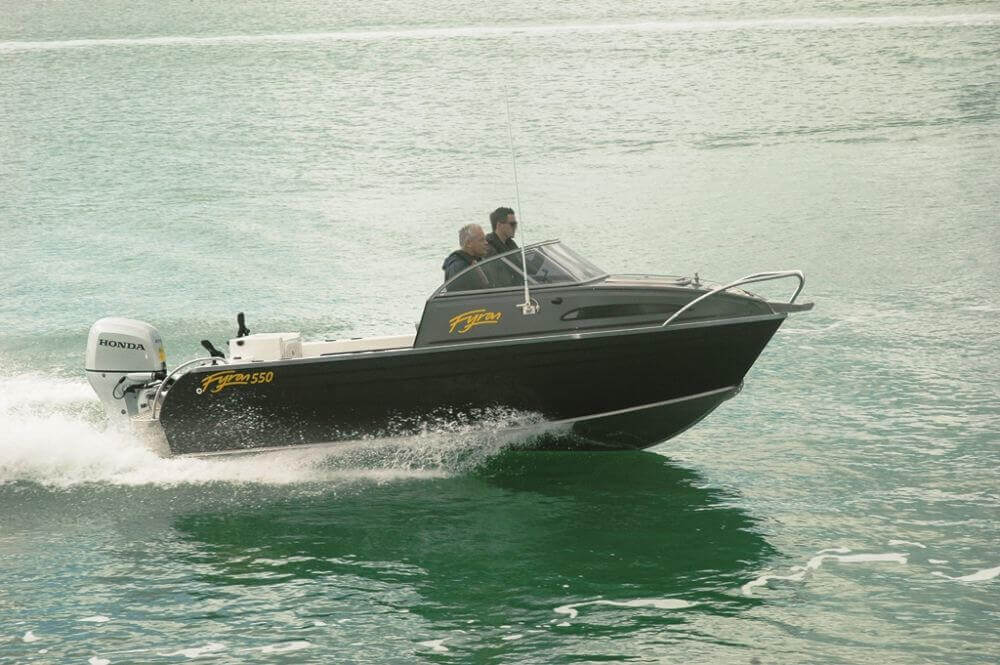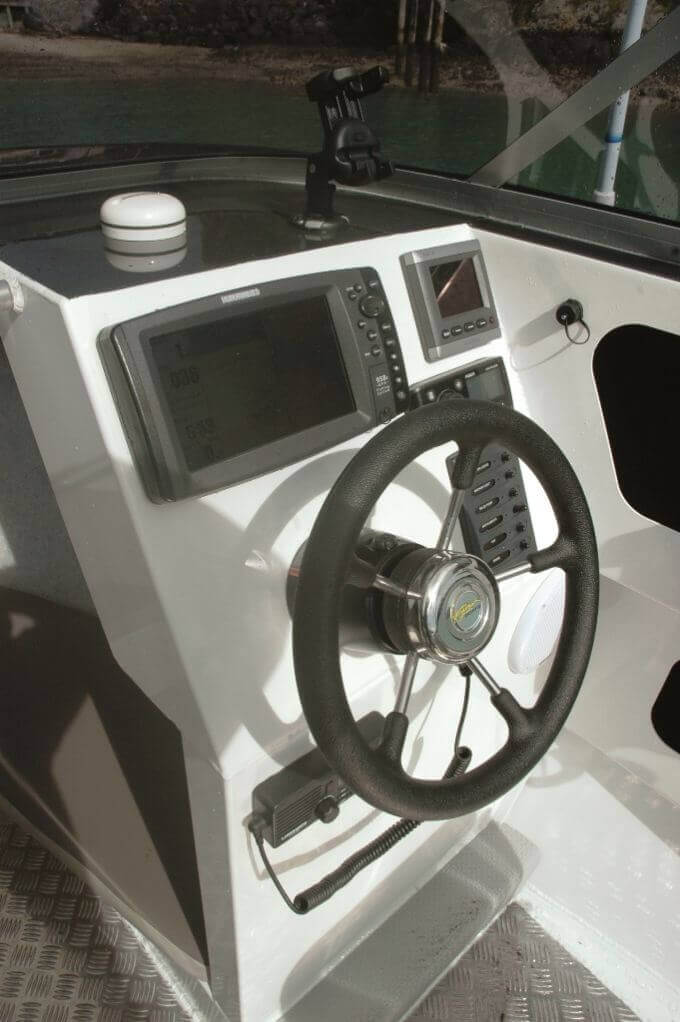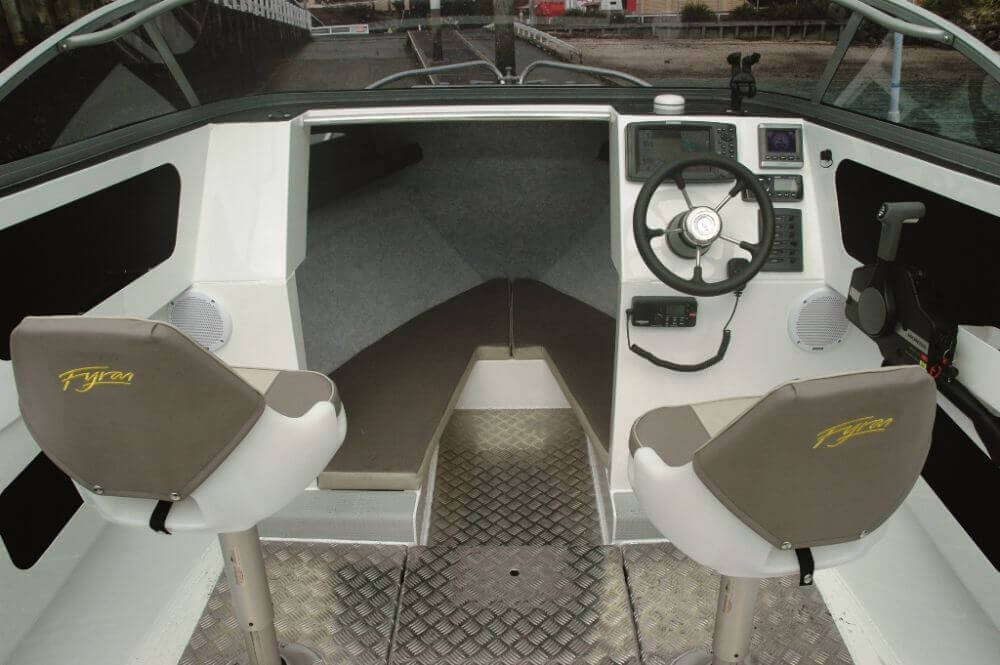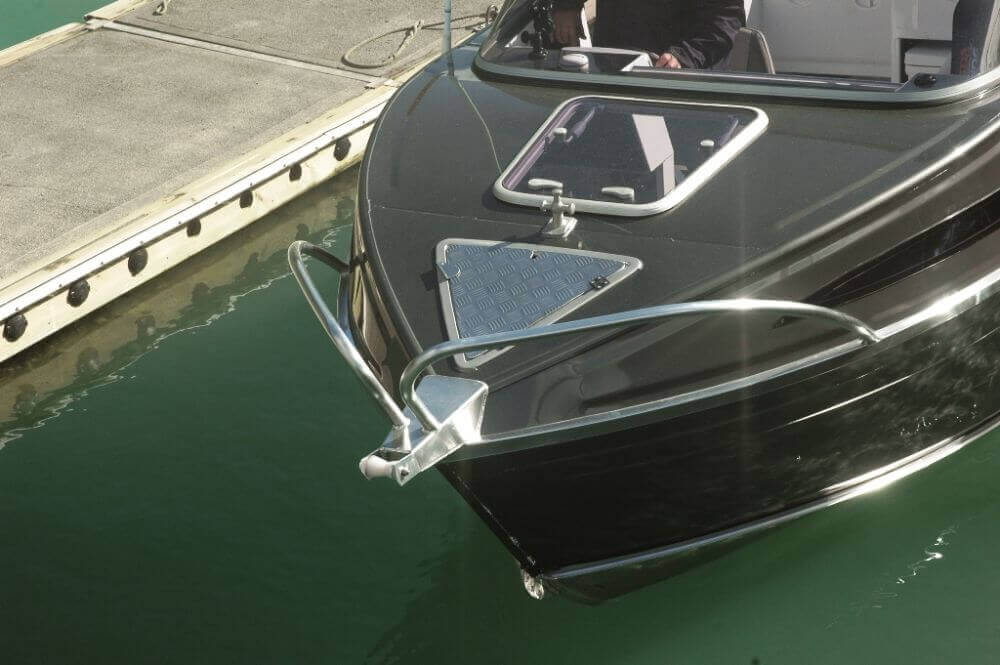With the 550, Fyran Boats has entered into a new era of boat design and construction. The Fyran 550 forms the basis of where the company is heading with all their trailer boats in the future.
Fyran is unquestionably the longest established production alloy boat builder in New Zealand, launching their first boat in 1969. Now 45 years later, the company is undergoing something of a rejuvenation, which is designed to re-establish the brand back into the forefront of a very competitive aluminium boat market.
Fyran Boats production manager, Nick Herd says that the older models will slowly be fazed out as the range is too vast and it needs some consolidation. “We will still offer a broad range of boats from our well-proven dinghies through to 7.6m hardtops, but there will not be so many variations in sizing and also, we are simplifying the branding to make size and model identification a lot easier.” Nick anticipates about 7-8 basic size models in the ‘new’ range.
Nick says that they will retain some of the hulls already in existence, but each will be given a total makeover both in layout and how they are put together. It is perhaps the way the new 550 are built now that denotes the way of the future for Fyran.
The improved manufacturing techniques, includes a lot more folded edges verses welding, creating kitset type components, such as topside pockets, helm station and bulkheads. It adds a lot to the visual appearance of the boats as well as simplifying the construction, saving both time and costs.
Another example is a change around the girders where the two treadplate floors meet each other, with the edges now folded rather than welded. This adds extra strength and eliminates the need for a long exposed weld on the floor.
The treadplate floor now butts into the gullwing joint, which decreases some of the welding required and has the bonus of also increasing the strength. Also, because the size of the treadplate span has been decreased to the internal girders, from the outside of the boat, there is no need to weld the floor to the sub-structure, – it’s now glued- leaving a cleaner finish to the inside of the boat.

And under the floor where you can’t see, all the girders are now folded to form an eye-beam that is welded to the hull. Again extra strength and extra stiffness. Two sealed chambers along with foam filled underfloor cavities bring the boat up to the CPC Flotation standards. The stiffness of the hull was certainly obvious on sea trials, when I was impressed with the solid feel of the boat in rough water. Gone was the ‘tinnie’ slap, so prevalent in a lot of the previous Fyrans.
A small but subtle change is that the new 550 has no plastic coated windlace edge trim anywhere, with all raw lips now radiused.
Externally one of the most-noticeable changes is the reduction of the hull clinker style, reduced from the original five to two that gives a cleaner look without compromising strength. It also takes away that ‘tinnie’ look. The gunnel also tucks in towards the stern, giving more shape to the hull and the cabin window line is sleeker, although still retains the traditional Fyran window, but removes some of the bulky looks of the cabin.

“We have put a lot of effort into the stern quarters of the boat, to give it a more curvaceous look and at the same time added even more stiffness to the hull,” says Nick.
While the Fyran 550 is based on the Fyran 575, – now discontinued- there are so many differences both in the hull and the layout, you would have to say that they are very different, although still sharing the same DNA.
The hull dimensions are the same, but there has been some changes to the bow with a finer entry and the warped vee on the bottom, as well as increasing the width and length of the gullwing chines, which now go further forward. All this helps towards a more stable and drier boat that is easily driven.
The boarding platforms either side of the outboard are larger than on the 575 and the transom has been modernised and reshaped with softer curves. A large diver-capable ladder is standard.

Fishing Cockpit
The cockpit is designed for fishing and there are plenty of obvious signs, such as the four rod holders and a dedicated bait station with cutting board. Storage is available under the wide flat aft deck, in a wet locker in the sole and full-length side and upper shelves. There’s a 65 litre fuel tank under the cockpit sole, with the option of an upgrade to 100 litres.
Fyran has also made sure the dash area is large and flat enough for larger multi-display screens, but still leaving space for all the other necessary switches and instruments. The Perspex screen is the same as was used on the Fyran 575 and comes with the option of a screen grab rail. Standard seating is twin pedestal seats, but you can upgrade to king/queen combinations if you require extra seating.

The cabin space is big enough for three adults to sit, with storage under the squabs and inside trays. Fyran have retained the nice wide entry of the 575 and the carpet lining is standard. With an extra wide bulkhead opening, the cabin feels very much an extension of the cockpit. A great place to keep your dry gear or the kids if they want a rest. Another change is the Fyran fabricated alloy hatch has been changed to a larger Cule hatch, which certainly looks a lot nicer.
A hardtop version of the 550 – 550HT- will be released later this year and will feature a solid alloy top with flat panel glass screens.


Stay Home Day
Test day was on Auckland Harbour and the weather was not great. It was the sort of cold wet miserable day that you would stay at home if you didn’t really need to go boating. Launching at Maraetai Boat Club, we got a small pocket of calm water off the foreshore that was enough to run the speed trials.
Power options allow for outboards from 70-100hp, with our Honda 100, running a 17” 3bld alloy propeller, returning a top speed with three aboard and a full 65 litres of fuel, of 34.7 knots/40 mph.
The Honda BF100 is a 1.5L, SOHC, 16-valve, inline four-cylinder engine is inspired by the same engine that powers one of Honda’s best-selling motor vehicles, the ‘Jazz’. The engine has a couple of neat features, including, BLAST, Honda’s advanced ignition timing control system, which significantly improves hole-shot performance; ECOmo, a fuel control system that contributes to the engines’ excellent fuel economy and VTEC, which provides more top end power while maintaining optimum fuel economy.

What impressed me was how easily the 550 got onto the plane and the fuel economy especially in the low to mid range. At 3000 rpm, we were on the plane and burned around 8.5 lph @ 10 knots. At 4000 rpm that increased to 16.8 lph @ 19 knots and at 5000 rpm 24.6 lph @ 26.5 knots.
Half a kilometre off Maraetai the sea was running short and steep, with about 20 knots of breeze. The 550 handled it well enough at 4000 rpm, heading into the sea with about ¼ trim and then in the following sea I increased that to 4500 rpm and about 1/3rd trim to get the best ride.
Stability at rest is very good and with two on one side the 550 didn’t display excess heel, although three was pushing it. Along for the trial, Steve Johnson, the dealer manager for Honda Marine in New Zealand, says, “ Compared to the 575, the 550 is a much tighter boat that rides better and when you come off a wave it lands softly and is extremely quiet.”
Going Forward
The make-over that has resulted in the Fyran 550 has produced a better boat, both in build quality and finish as well as looks. The sleek redesign goes further than what you can see on the outside and that’s something that Nick says will be carried through all the ‘new’ models to come.

The make-over that has resulted in the Fyran 550 has produced a better boat, both in build quality and finish as well as looks. The sleek redesign goes further than what you can see on the outside and that’s something that Nick says will be carried through all the ‘new’ models to come.
TECHNICAL
- Make & model: Fyran 550
- Priced from: $NZ27000 (Boat & Trailer)
- Price as tested: $NZ53,765 (motor/boat/trailer)
- Type: Cabin Runabout
- Construction: 4mm/3mm
- LOA: 5.50m
- Beam: 2.10m
- Deadrise: 16 deg
- Height on trailer: 2.20m
- Trailerable weight: 840 kgs
- Test Power: Honda 100
- Propeller: 17” 3bld Alloy
- Power options: Outboard Only
- HP Range: 70-100 hp
- Fuel capacity: 65 litres
- Trailer: Hosking




